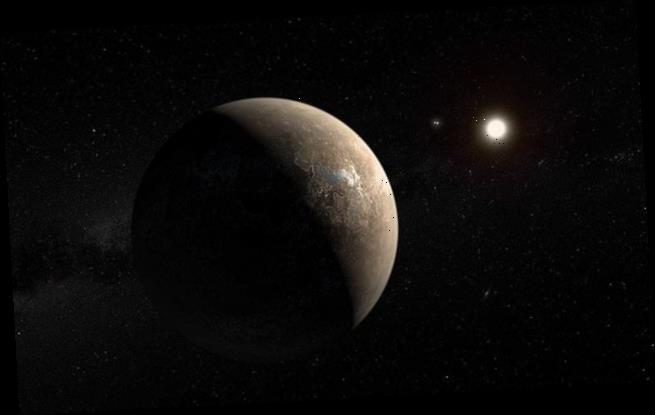Presence of Proxima b Earth-sized planet is CONFIRMED by scientists who suggest it may have liquid water and host life
- Proxima b was first spotted in 2016, but now its presence has been confirmed
- The team used new technology to determine its mass and orbiting time
- Proxima b has a mass 1.7 times that of Earth and orbits its star every 11 days
- It is also close enough to its star to get the same energy Earth does from its sun
- This suggests there may be liquid water on the surface and ability to host life
Scientist have made a breakthrough discovery – they have confirmed the presence of Proxima b, an Earth-like planet that 4.2 light-years-away from the sun.
The planet has a mass of 1.17 Earths and sits in the habitable zone of Proxima Centauri, which it orbits every 11 days.
Proxima b was first discovered in 2016 using HARPS (High Accuracy Radial Velocity Planet Searcher), but the recent probe was conducted with ESPRESSO, that has three times the precision, allowing for exact data on the exoplanet’s size and timing of orbits.
The new analysis determined that the distant world receives about the same amount of energy from its star as Earth does from the sun.
This means that its surface temperature could mean that water would be in liquid form and may potentially be harboring life.
Scroll down for video
Scientist have made a breakthrough discovery – they have confirmed the existence of Proxima b, an Earth-like planet that 4.2 light-years-away from the sun. The planet has a mass of 1.17 Earths and sits in the habitable zone of Proxima Centauri, which it orbits every 11 days
Michel Mayor, winner of the Nobel Prize for Physics in 2019, honorary professor in the Faculty of Science and the ‘architect’ of all ESPRESSO-type instruments, said: ‘ESPRESSO has made it possible to measure the mass of the planet with a precision of over one-tenth of the mass of Earth.’
‘It’s completely unheard of.’
Proxima b was first discovered by astronomers using the European Southern Observatory (ESO) telescope HARPS.
‘Context. The discovery of Proxima b marked one of the most important milestones in exoplanetary science in recent years,’ reads the new study published in arXiv.
‘Yet the limited precision of the available radial velocity data and the difficulty in modelling the stellar activity calls for a confirmation of the Earth-mass planet.
The analysis determined that the distant world receives about the same amount of energy from its star as Earth does from the sun. This means that water would be in liquid form and may potentially be harboring life.
‘We aim to confirm the presence of Proxima b using independent measurements obtained with the new ESPRESSO spectrograph, and refine the planetary parameters taking advantage of its improved precision.’
The rocky planet is only 4.6 million miles from the star, 5 percent of the distance between the Earth and the sun, and takes just 11.2 days to complete one orbit.
The temperature on the surface could be between -130 and 86 Fahrenheit.
The first observation suggested the exoplanet had a mass 1.3 times the mass of Earth, but the new analysis has determined it is 1.7 times that of our planet.
Francesco Pepe, leader of the ESPRESSO research team and a professor of astronomy at the University of Geneva in Switzerland, said:’ We were already very happy with the performance of HARPS, which has been responsible for discovering hundreds of exoplanets over the last 17 years.’
‘We’re really pleased that ESPRESSO can produce even better measurements, and it’s gratifying and just reward for the teamwork lasting nearly 10 years.’
The team noted that determining the precise measurements of Proxima b brings them one-step closing to finding life on the planet.
With the theory that the exoplanet may have liquid water, the team also understands that more research is necessary to determine if life has ever developed on the surface.
On the downside, the Proxima star is an active red dwarf that bombards its planet with X rays, receiving about 400 times more than the Earth.
And any life that may have evolved would likely of been hardened against the radiation.
Source: Read Full Article


